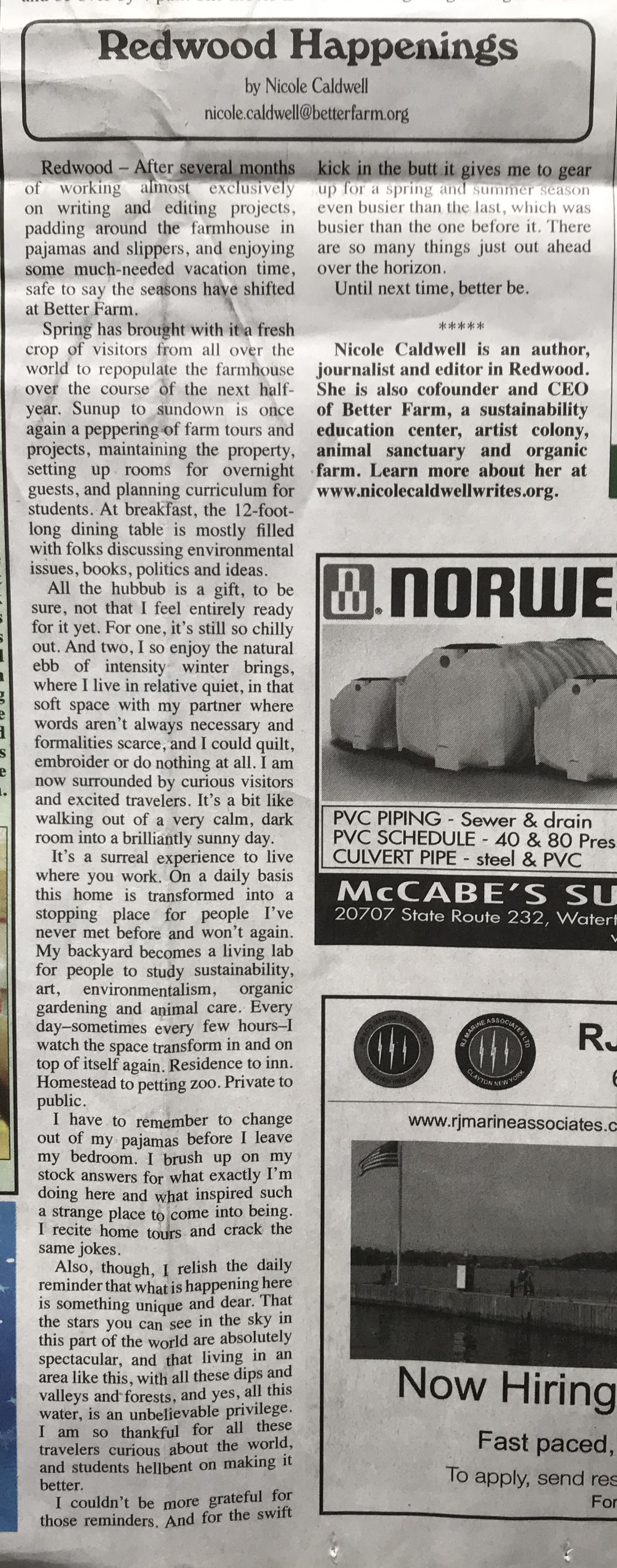By Nicole Caldwell for the Thousand Islands Sun
I was outside checking on our beehive this morning when the drumming started.
Somewhere ahead of me, through the feathered edge of young forest running along the east property line at Better Farm, came the unmistakable thud-thud-thud of a lawnmower or small motorcycle starting up somewhere in the woods.
It took me a second to realize what the noise actually was. Every winter, I forget some of the sounds from the seasons before. I had a small laugh at my expense when I realized what I was actually listening to.
The source of this steady rhythm was a chubby, round creature barely bigger than a pigeon who suffices to beat his wings together for a few seconds at a time, over and over, in order to find a girlfriend. All the while this little cherub is thumping his feathered arms together, his bird-brained friends bother with the silly nonsense of calling in their mates with song.
The coloring of ruffed grouse makes them blend seamlessly into their surroundings. The birds are all shades of neutral browns, greys and tans, with a spiky little hairdo that makes them appear permanently alert—if you can find them, that is. Their elusiveness is part of their charming, notorious drumming. These guys seem to come from nowhere, even though ruffed grouse often select the same stump or log upon which to stand while thundering their wings together year after year, for upwards of a decade. They live in New York State throughout the seasons, waiting (mostly) quietly for the freeze to break, savoring winter for its still silence.
Spring is for singing. Chirping. And drumming to one’s heart’s content.
I have no ambivalence about my love of spring sounds, not the least of which being bird calls. I’m a terrible birder, but have through the years acquired the unimpressive ability to discern between an owl and whip-poor-will, chickadee and golden-winged warbler. Generally, I just enjoy hearing the symphony outside. But there’s something about that drumming that evokes a sense of restlessness. The sound, once you hear it, surpasses all other sounds of nature in my backyard.
Neuroscience research confirms that talented drummers have clear, anatomical differences from the rest of the herd; namely, an intuitive understanding of rhythms and patterns happening all around us. That intuition gives human drummers a leg up when it comes to analytical thinking, perception, and logic.
The purpose of drumming, at its essence, is communication. That’s true whether you’re a ruffed grouse or part of a marching band. The drum has been central for all time to dance, sporting events, ceremonies and religious rites, and even as a lead-up to war. Each of these is a method for communication, necessary or frivolous. Their universal use has allowed drums to firmly plant their flags in every culture on earth. All this is to say, you can’t separate the drum from our experience as human beings—or as animals.
In nature, we’re designed to seek out rhythms. The noises you hear on a warm night outside might collectively present as a disorganized jumble of high and low notes. But as you suss out the separate sounds therein, you find unmistakable rhythms and measures. Bird songs, frog croaks, bat calls, and those lovable cicadas. We’re hardwired to appreciate the repetition of a steady beat.
Which must be why I lingered in that chilly morning air, looking out toward the woods and waiting for the next lick of buh-buh-buh-buh-buh-buh to sound.
It did. I smiled.
Until next time, better be.
Nicole Caldwell is an author, journalist and editor in Redwood. She is also co-founder and CEO of Better Farm, a sustainability campus, artist colony, animal sanctuary and organic farm. Learn more about Caldwell at www.nicolecaldwellwrites.com.








